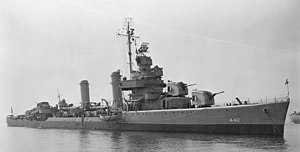USS Ericsson (DD-440)
 |
|
| History | |
|---|---|
|
|
|
| Name: | Ericsson |
| Namesake: | John Ericsson |
| Operator: | United States Navy |
| Builder: | Federal Shipbuilding and Drydock Company |
| Laid down: | 18 March 1940 |
| Launched: | 23 November 1940 |
| Commissioned: | 13 March 1941 |
| Decommissioned: | 15 March 1946 |
| Struck: | 1 June 1970 |
| Fate: | Sunk as target 17 November 1970 |
| General characteristics | |
| Class and type: | Gleaves-class destroyer |
| Displacement: | 1,630 tons |
| Length: | 348 ft 3 in (106.15 m) |
| Beam: | 36 ft 1 in (11.00 m) |
| Draft: | 11 ft 10 in (3.61 m) |
| Propulsion: |
|
| Speed: | 37.4 knots (69 km/h) |
| Range: | 6,500 nmi (12,000 km; 7,500 mi) at 12 kn (22 km/h; 14 mph) |
| Complement: | 16 officers, 260 enlisted |
| Armament: |
|
USS Ericsson (DD-440), a Gleaves-class destroyer, was the third ship of the United States Navy to be named after John Ericsson, who is best known for devising and building the Civil War ironclad USS Monitor.
Ericsson was launched on 23 November 1940 by Federal Shipbuilding and Drydock Co., Kearny, New Jersey; sponsored by Mrs. Ruth E. Wallgren, great-great-grandniece of John Ericsson. The ship was commissioned on 13 March 1941, Lieutenant Commander G. E. Sage in command.
After shakedown, Ericsson arrived at Norfolk, Virginia, her home port, on 2 May 1941. Immediately Ericsson began operations along the East Coast and Bermuda, training Naval Reserve midshipmen, exercising with submarines, making tests of her equipment and machinery, and joining in battle practice. In the fall of 1941, she twice voyaged to Newfoundland and Iceland, escorting convoys, continuing this service after the United States entered World War II. Patrolling off NS Argentia, Newfoundland on 15 January 1942, she sighted the life rafts of sunken SS Dagrose, from which she rescued two survivors. Her rescue work also includes patrol service during the rescue of survivors from the torpedoed Coast Guard cutter USCGC Hamilton on 30 January 1942.
...
Wikipedia
